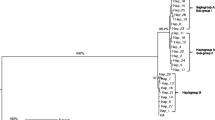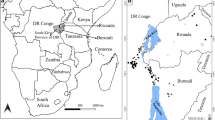Abstract
Studies in the biology, ecology and behaviour of R. appendiculatus in Zambia have shown considerable variation within and between populations often associated with their geographical origin. We studied variation in the mitochondrial COI (mtCOI) gene of adult R. appendiculatus ticks originating from the Eastern and Southern provinces of Zambia. Rhipicephalus appendiculatus ticks from the two provinces were placed into two groups on the mtCOI sequence data tree. One group comprised all haplotypes of specimens from the Eastern province plateau districts of Chipata and Petauke. The second group consisted of a single haplotype of specimens from the Southern province districts and Nyimba, an Eastern province district on the fringes of the valley. This variation provides additional evidence to the earlier observations in the 12S rDNA and ITS2 data for the geographic subdivision of R. appendiculatus from Southern province and Eastern province plateau. The geographic subdivision further corresponds with differences in body size and diapause between R. appendiculatus from these geographic areas. The possible implications of these findings on the epidemiology of East Coast fever (ECF) the disease for which R. appendiculatus is one of the vectors are discussed.




Similar content being viewed by others
References
Avise JC (2000) Phylogeography: the history and formation of species. Harvard University Press, Cambridge and London
Berkvens DL, Pegram RG, Brandt JRA (1995) A study of the diapausing behaviour of Rhipicephalus appendiculatus and R. zambeziensis under quasi-natural conditions in Zambia. Med Vet Entomol 9:307–315
Berkvens DL, Geysen DM, Chaka G, Madder M, Brandt JRA (1998) A survey of the Ixodid ticks parasitizing cattle in the Eastern Province of Zambia. Med Vet Entomol 12:234–240
Billiouw M (2005) The epidemiology of bovine theileriosis in the eastern province of Zambia. PhD thesis, Ghent University, Ghent, Belgium
Boom R, Sol CJA, Salimans MMM, Jansen CL, Wertheim-van Dillen PME, Van Der Noordaa J (1990) Rapid and simple method of purification of nucleic acids. J Clin Microbiol 28:495–503
Boom R, Sol C, Beld M, Weel J, Goudsmit J, Wertheim-van Dillen PME (1999) Improved silica-guanidiniumthiocyanate DNA isolation procedure based on selective binding of bovine alpha-casein to silica particles. J Clin Microbiol 37:615–619
Chaka G, Billiouw M, Geysen DM, Berkvens DL (1999) Spatial and temporal variation in Rhipicephalus appendiculatus size in eastern Zambia. Trop Med Int Health 4:A43–A48
Chaka G, Madder M, Speybroeck N, Tempia S, Tona K, Berkvens D (2001) Determination of physiological age of Rhipicephalus appendiculatus (Acari: Ixodidae). Syst Appl Acarol 10:1–16
Chaka G (2001) Eco-physiology of Rhipicephalus appendiculatus (Acari: Ixodidae) in eastern Zambia. PhD Thesis, Institute of Tropical Medicine, Antwerp (ITMA), Antwerp, Belgium, pp 89–105
Madder M (1999) Behavioural Diapause in Rhipicephalus appendiculatus Neumann (Acari: Ixodidae), PhD Thesis, Ghent University, pp 109–122
Madder M, Speybroeck N, Brandt J, Tirry L, Hodek I, Berkvens D (2002) Geographic variation in diapause response of adult Rhipicephalus appendiculatus ticks. Exp Appl Acarol 27:209–221
McLain DK, Wesson DM, Olivier JH Jr, Collins FH (1995) Variation in ribosomal DNA internal transcribed spacer 1 among Eastern populations of Ixodes scapularis (Acari: Ixodidae). J Med Entomol 32:353–360
Mtambo J, Van Bortel W, Madder M, Roelants P, Backeljau T (2006) Comparison of preservation methods of Rhipicephalus appendiculatus (Acari:Ixodidae) for reliable DNA amplification by PCR. Exp Appl Acarol 38:189–199
Mulumba M, Speybroeck N, Billiouw M, Berkvens DL, Geysen DM, Brandt JRA (2000) Transmission of theileriosis in the traditional sector in the southern province of Zambia during 1995–1996. Trop Animal Health Prod 38:303–314
Nicholas KB, Nicholas HB Jr (1997) GeneDoc: a tool for editing and annotating multiple sequence alignments. Distributed by author. http://www.psc.edu/biomed/genedoc/gddl.htm
Norval RAI, Perry BD, Young AS (1992) The epidemiology of theileriosis in Africa. Academic Press, London, pp 99
Ronquist F, Huelsenbeck JP (2003) MRBAYES: Bayesian phylogenies under mixed models. Bioinformatics 19:1572–1574
Pegram RG, Perry BD, Musisi FL, Mwanaumo B (1986) Ecology and phenology of ticks in Zambia: seasonal dynamics in cattle. Exp Appl Acarol 2:25–45
Posada D, Crandall KA (1998) Modeltest: testing the model of DNA substitution. Bioinformatics 14:817–818
Speybroeck N, Madder M, Van Den Bossche P, Mtambo J, Berkvens N, Chaka G, Mulumba M, Brandt J, Tirry L, Berkvens D (2002) Distribution and phenology of ixodid ticks in Southern Zambia. Med Vet Entomol 16:430–441
Speybroeck N, Madder M, Thulke HH, Mtambo J, Tirry L, Chaka G, Marcotty T, Berkvens D (2004) Variation in body size in the tick complex Rhipicephalus appendiculatus/Rhipicephalus zambeziensis. J vector Ecol 29:347–354
Swofford DL (2003) PAUP* phylogenetic analysis using parsimony (*and other methods). Sinauer Associates, Sunderland, MA
Tempia S (1997) Comparison of the vectorial capacity of Rhipicephalus appendiculatus (Acari: Ixodidae) nymphs and adults originating from eastern and southern provinces of Zambia infected by Theileria parva Katete stock. M.Sc. Thesis 65, Institute of Tropical Medicine, Antwerp (ITMA), Belgium
Thompson JD, Gibson TJ, Plewniak F, Jeanmougin F, Higgins DG (1997) The ClustalX windows interface: flexible strategies for multiple sequence alignment aided by quality analysis tools. Nucleic Acids Res 25:4876–4882
Walker JB, Keirans JE, Horak IG (2000) The Genus Rhipicephalus (Acari: Ixodidae): a guide to the brown ticks of the world. Cambridge University Press, Cambridge
Acknowledgements
This work was funded by the Belgian Technical Co-operation through the “Assistance to the Veterinary Services of Zambia (ASVEZA) project in the Southern Province. We thank the farmers of the two provinces for their co-operation. Special thanks to Mr Geff Mukwalantila without whose commitment collections from Petauke and Nyimba would have not been possible.
Author information
Authors and Affiliations
Corresponding author
Additional information
Nucleotide sequence data reported in this paper are available in the GenBankTM under the Accession Numbers DQ859259–DQ859266
Rights and permissions
About this article
Cite this article
Mtambo, J., Madder, M., Van Bortel, W. et al. Further evidence for geographic differentiation in R. appendiculatus (Acari: Ixodidae) from Eastern and Southern provinces of Zambia. Exp Appl Acarol 41, 129–138 (2007). https://doi.org/10.1007/s10493-007-9049-2
Received:
Accepted:
Published:
Issue Date:
DOI: https://doi.org/10.1007/s10493-007-9049-2




